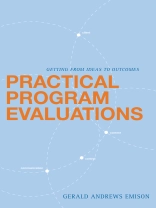Program evaluation requires attention to rationality, rigor, and careful methods. Yet precision and accuracy alone do not guarantee that program evaluations will be implemented. What prevents an evaluation from being thrown on a shelf to gather dust?
Author Gerald Emison, a practitioner with more than 20 years experience, knows that the consumers of program evaluations operate in a decidedly practical and political arena where decision making is a very human and sometimes messy process. Getting students from ideas to outcomes means that knowing clients’ needs and effectively communicating results are just as crucial as an evaluator’s theoretical knowledge and statistical analysis. Emison wants to help students translate their mastery of methodology into useable program evaluations that are implemented and affect actual programs.
Short and to-the-point, Practical Program Evaluations hones in on the applied side of program evaluation, with the goal of creating and presenting program evaluations that are used and improve public enterprises. A handy supplement to core texts, Emison offers honest advice, emphasizing practices that focus on the client, content, control and communication of program evaluations.
Yazar hakkında
Gerald Andrews Emison is an Associate Professor of Political Science and Public Administration at Mississippi State University. At MSU, he teaches public management and environmental policy. His research interests concern the effectiveness of public environmental institutions, professionalism in city planning and engineering, and environmental consequences of growth management.
Prior to joining to MSU, Emison served in a number of senior executive positions with the U.S. Environmental Protection Agency as the Director of the Program Evaluation Division, Director of the Office of Air Quality Planning and Standards and the Deputy Regional Administrator in Seattle. In his executive capacities, he produced as well as was the customer for program and policy analyses on vital public issues. Among his activities he was an architect of the Clean Air Act of 1990, supervised EPA’s clean up responsibilities at the Hanford Nuclear Reservation and managed the Spotted Owl controversy for EPA. As a result of his work at EPA he received the presidential rank designation for meritorious senior executive service.
He received his Ph.D. in City and Regional Planning from the University of North Carolina at Chapel Hill. He also holds additional graduate degrees in Political Science and Engineering Management. His undergraduate work was in Civil Engineering, and was followed by service in the Seabees in Viet Nam. He is a registered professional engineer, a board-certified diplomate of the American Academy of Environmental Engineers and a member of the American Institute of Certified Planners.












